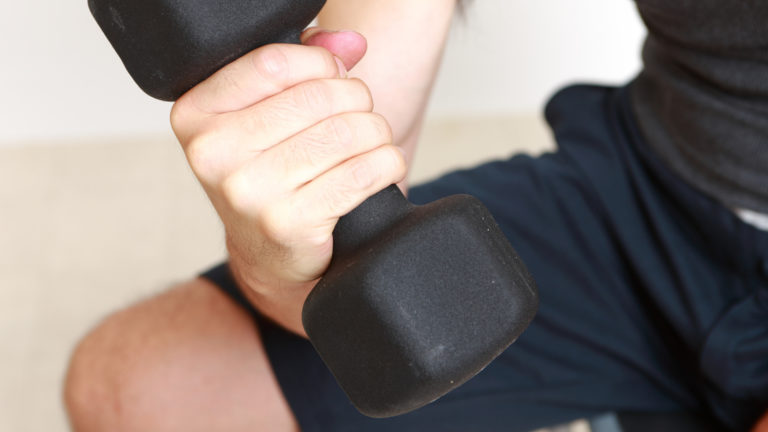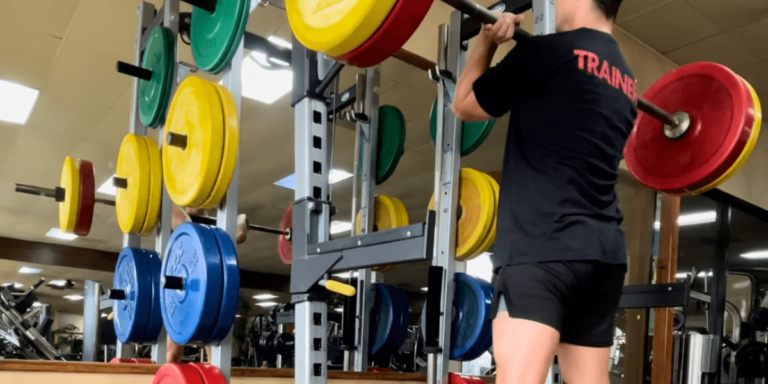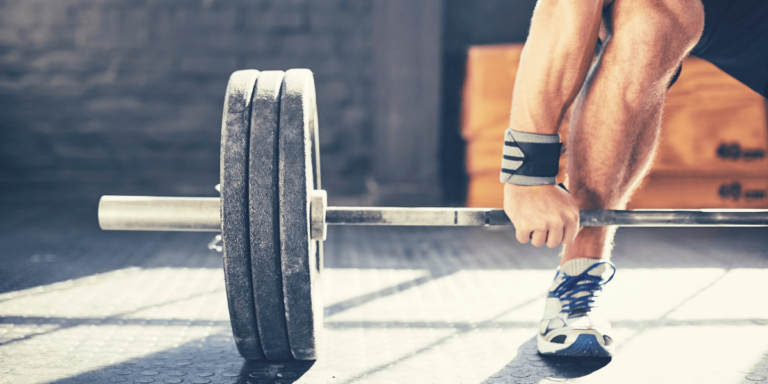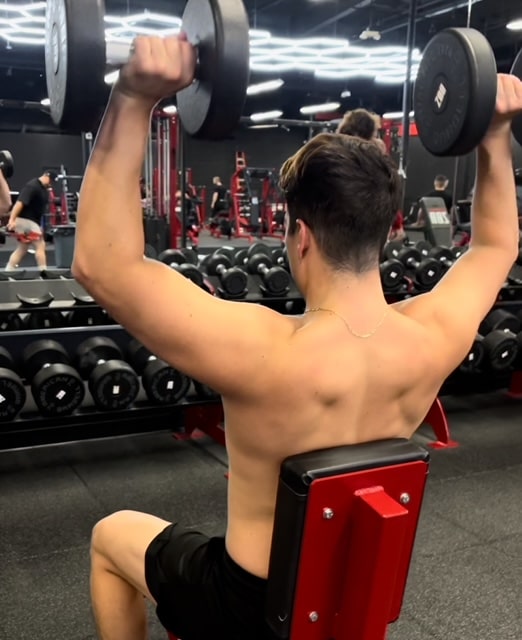Chest Supported Dumbbell Row | How To Build Solid Back Gains
The Chest Supported Dumbbell Row is one of my favorite exercises to target the back muscles. I always include this in my and my clients’ programs, whether they train with me in person or online from their home gym and whether they are advanced lifters or beginners.
It’s a great beginner exercise that can be performed from anywhere. All you need is an incline bench and a pair of adjustable dumbbells.
If you want to grow your back, include this awesome exercise in your strength training program.
What is the Chest Supported Dumbbell Row?
The chest-supported dumbbell row is a variation of the traditional bent-over row. Instead of standing and bending over to perform the movement, you are supported by an incline bench (at a 45-degree angle) with your chest to stabilize your body and minimize loading on the spine.
This exercise primarily targets the back muscles, specifically the posterior delts, lats, rhomboids, and traps. It also engages your biceps as secondary muscles.
Step-by-Step Instructions to Perform the Chest-Supported Dumbbell Row
Setting Up The Bench
Note: Each incline bench is going to differ slightly. Check yours to see if specific recommendations vary.
Setting up your incline will ensure your torso is in the proper position and not too upright.
The starting position is always the first step. Keeping the bench at a 45-degree angle is a good rule of thumb. Check the photo above for examples of what notch to set it at.
Choose Your Weights + Grip
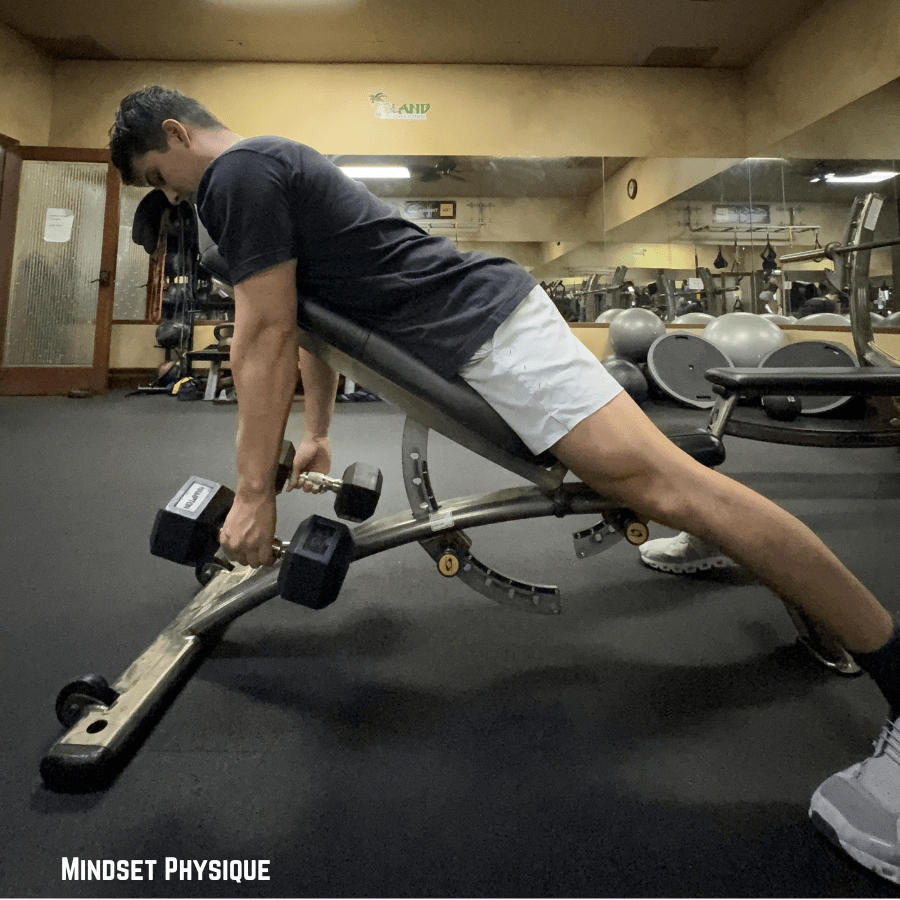
Next, grab two dumbbells of the same weight and place one on each side of the bench. Ensure your Chest is supported and your legs are straight but with a slight bend in the knees.
Keep your toes firmly planted on the ground with your heels off the ground. When you grab the dumbbells, make sure your palms face each other, known as a neutral grip.
Neutral grip is what I recommend for beginners as you’re working more muscles, and it’s easier to overload with heavier weight over time.
Row, Squeeze, Release

Now that we’re all ready to go, it’s time to perform the exercise.
When rowing, focus on pulling your elbows back. We don’t want to raise the elbows.
As a trainer, I always cue my clients to focus on pulling their elbows back when performing the row.
Remember to avoid letting your shoulders shrug. Keep those shoulders packed down.
As you pull back, squeeze your shoulder blades at the top of the movement and slowly lower on the eccentric phase, ideally taking 3 seconds to return to the starting position.
From there, repeat the motion for your desired reps based on the program you’re following.
Chest Supported Dumbbell Row Mistakes
I see three common things that could be improved with clients when performing the chest-supported row. All are easy fixes.
Setting Bench Too High
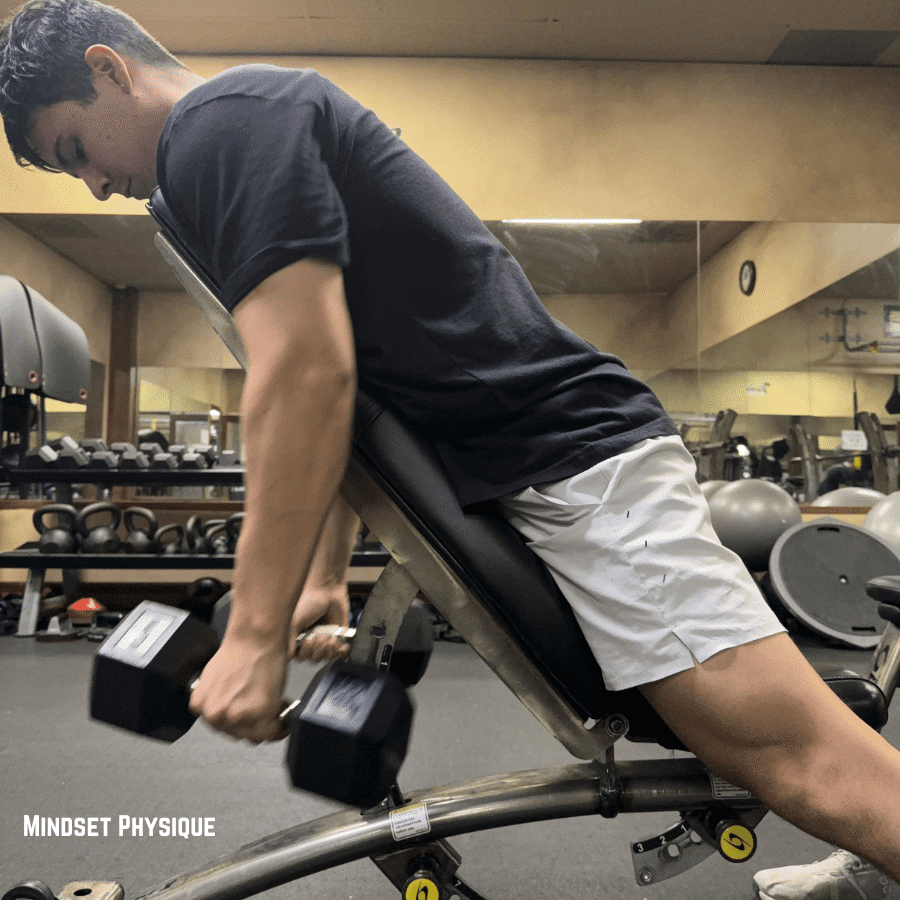
Gravity won’t be in your favor if your bench is set too high. The primary goal is to target the upper back muscles, targeting the rear delts and lats as the primary muscles. The higher the bench, the less you’ll feel those muscles working.
Refer to the photo above for which notch you should set your incline bench.
Shrugging Your Shoulders
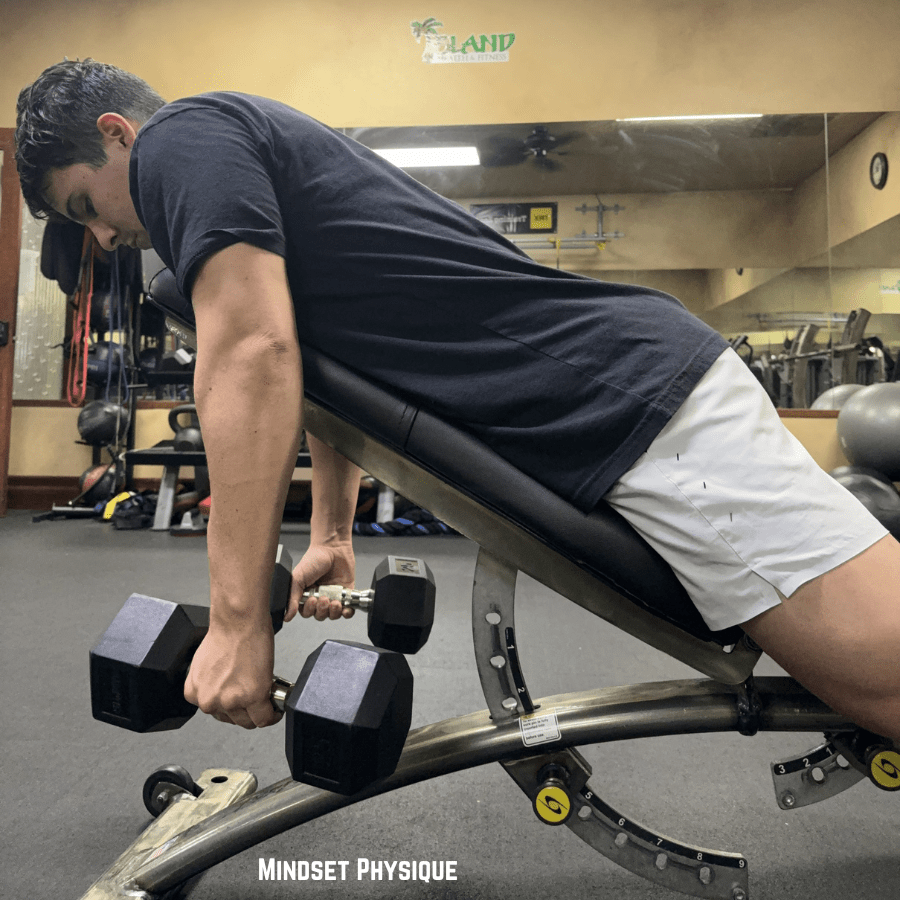
Another common mistake I see is clients shrug their shoulders, which causes their elbows to come up versus pulling back.
To fix this, focus on keeping your shoulders down and pulling your elbows back, as mentioned earlier.
Awkward Position on the Bench
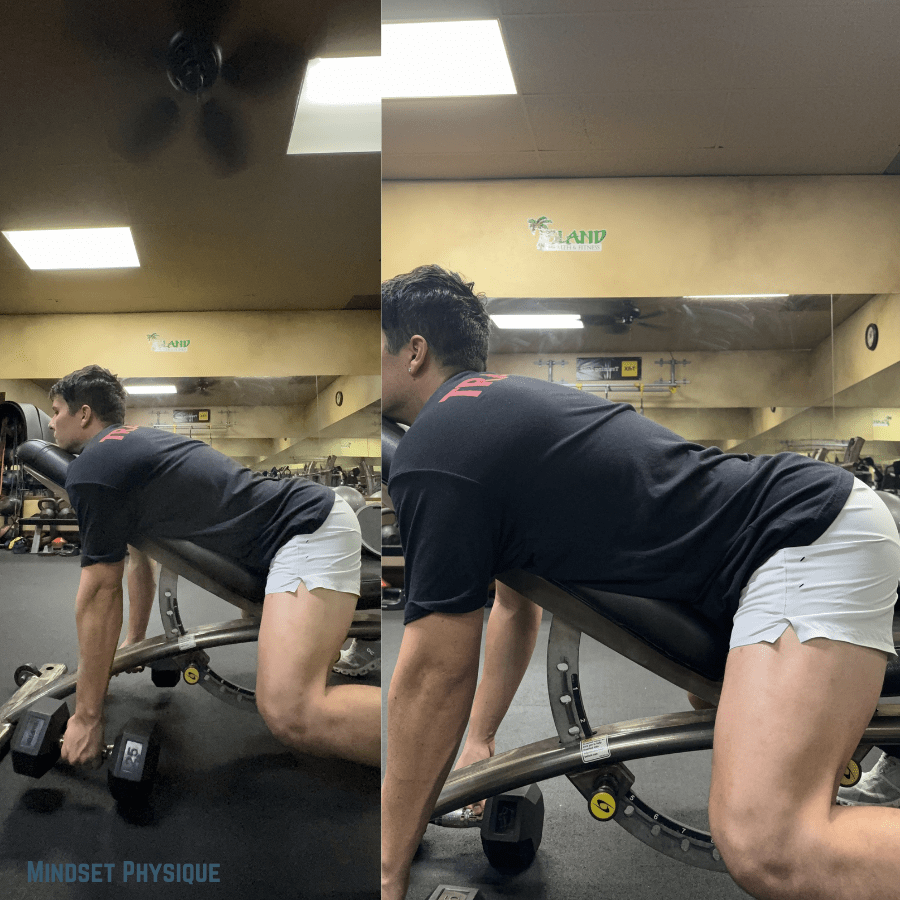
The last mistake I see is an awkward position on the bench. For example, I’ll see a client’s head facing directly on the bench, with an arch in their back.
Finding a comfortable position for your Chest to lie flat on the bench at an incline level can take some work.
To fix this issue, ensure your toes are planted firmly on the ground with your hips and Chest touching the pad. Keep your legs straight, but keep a slight bend in the knees.
This will help stabilize your body throughout the movement, allowing you to focus solely on movement.
Chest Supported Dumbbell Row Benefits
Easy on the spine
One of the best benefits of this exercise is easy loading on the spine. Unlike a bent-over dumbbell or barbell row, where your body is less stable and more core activation is needed, chest-supported rows with dumbbells allow for a more neutral spine position. This can be especially helpful for those with lower back issues or injuries who need that exercise regression.
Great for beginners
Further to easier loading on the spine, this is especially helpful for beginner lifters. It removes the difficulty of balancing or stabilizing your body during the movement.
If a beginner needs to strengthen their core, I will typically work on that separately with ab exercises. Regarding rows, I will give them an exercise like chest-supported rows or single-arm rows where they are more stable, instead of bent-over rows, until they work up to that progression with a stronger core.
This allows beginners to focus solely on technique and working the correct muscles without worrying about balance.
Great to Overload
Because you’re more stable with your Chest supported and less loading on the spine, it’s easier to go heavy and overload the muscles working when performing this exercise over time in your training regimen to help you progress.
Chest Supported Dumbbell Row Muscles Worked
Agonist (Main Muscles Targeted):
- Posterior Deltoids (Rear Delts)
- Latissimus Dorsi (Lats)
Synergist:
- Biceps Brachii
- Middle Trapezius
- Rhomboid Major & Minor
This exercise is part of the horizontal pull movement pattern, so it will work the same muscles as other rows like bent-over or cable rows.
However, because one of the benefits is less loading on the spine, it’s easier to overload these muscles being worked versus its sister exercises like a bent-over barbell row.
That’s not to say they are terrible exercises, but the answer is it depends.
It depends on the individual and what you train for (hypertrophy vs. strength) (bodybuilding vs. powerlifting).
Sets and Repetitions
How many sets and repetitions should you do when performing this exercise?
I will throw the It depends answer at you again in this article.
It depends on what you’re training for:
Strength: 1-5 repetitions | 3-4 sets
Hypertrophy: 6-12 repitions | 3-4 sets
Endurance: 12-15 repetitions: | 3-5 sets
Reasons You Need to Know the Chest-Supported Dumbbell Row
Here are some reasons why you need to incorporate the Chest Supported Dumbbell Row into your workout routine:
- Gym accessibility: Chest-supported rows can be performed in any gym setting. You don’t have to wait for a specific machine or equipment. Alternatively, this can be done from home with an incline bench and some dumbbells.
- Back muscles: Since your Chest is supported, your body is more stable, allowing better control with the free weights to target the back muscles being worked without compensating form.
- Injury prevention: The incline bench supports your Chest and minimizes stress on your lower back. It’s perfect for those with lower back issues or beginners still working on their form.
Frequently Asked Questions
Chest Supported Dumbbell Row Muscles Worked
The muscles being worked are the rear delts, lats, rhomboids, biceps, and middle traps. Certain muscles within this group will be targeted more or less depending on your grip (pronated vs. neutral vs. supinated).
Chest Supported Dumbbell Rows Alternatives
The other alternatives are horizontal pull-focused exercises targeting the same muscles mentioned above. These are your cable rows, barbell and dumbbell bent over rows, T Bar, and pendalay rows. You can also include single-arm variations in this category, including single-arm cable and bent-over dumbbell rows.
Chest Supported Dumbbell Row Best, Bench Angle
Check the specific incline bench at your gym. However, a general rule of thumb will be to notch number 3 or 4 from the bottom (keep the bench at a 45-degree angle).
Chest-Supported Dumbbell Sets and Reps
For hypertrophy (muscle mass increase): 6-12 repetitions | 3-4 sets
For Strength: 1-5 repetitions | 3-4 sets
For Endurance: 12-15 repetitions: | 3-5 sets
These numbers aren’t set and dictated. This is just the typical range for hypertrophy, strength, and endurance.
Chest-Supported Dumbbell Row vs Machine | Which is Better?
Not one is better than the other. They are just different. Both should be included in your training regimen at one point or another.
Chest Supported Dumbbell Row vs Barbell Row | Which is Better?
Not one is better than the other. They are just different. Both should be included in your training regimen at one point or another. Barbell rows are a bit more advanced, so I don’t always program this exercise for beginner lifters. We’ll typically work on core strengthening and other “rowing” exercises to work up to the barbell.
Final Thoughts
Hopefully, this clears up everything you need regarding the chest-supported dumbbell row exercise.
Whether you are a beginner, intermediate, or advanced lifter, this is a great exercise.
My own coach programs this exercise 90% of the time in the two years I’ve been working with him, and it’s been amazing to see the gains I’ve made with my back from this exercise alone.
Pay attention to all your exercises, focusing on the horizontal pull movement pattern! Add this exercise, switch it up with some variations every 2-4 weeks, and then bring it back over time.
Track your lifts from every session (weight and repetitions done) and see how to keep improving!
